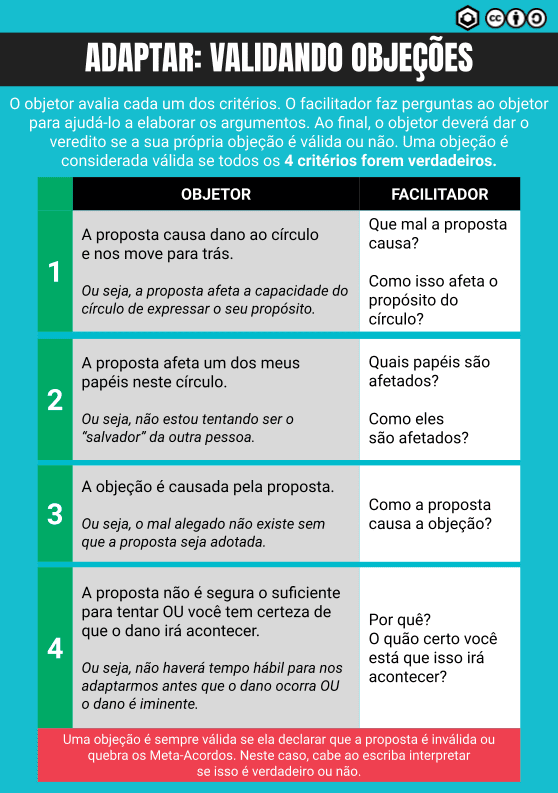This is another post in a sequence that talks about the 5 interactions of the Organic Organization. Today it’s the turn of the Adapt Interaction, used to change the organizational structure.
Contrary to what many think, most decisions in an Organic Organization are not made in groups, or by consensus. Doing so would be extremely counterproductive, given the large volume of decisions we make daily (like deciding to write this paragraph this way) in addition to the biases and undesirable effects of consensus.
We often describe O2 as a “distributed autocracy,” that is, a system where we seek to give autonomy so that people in their roles can make most of the decisions autocratically (individually). To make this possible, we use an explicit organizational structure composed of roles, circles and constraints. It is our agreement map with combinations about how far the autonomy of each role goes.
The organizational structure, however, needs to be dynamic. It is good to remember that our organizations navigate in a complex environment. Every day we learn new things that need to be incorporated into our agreements. Therefore, the agreement map is constantly evolving and adapting.
The systemic impact of the distribution of authority
In the role of Content Producer, I can decide to produce several texts for this blog, as I am doing now. I didn’t consult anyone for that. I simply had the idea (and the will) to write another post about the interactions of O2 and started this one. Of course, this makes sense for my role, whose purpose is high-quality content optimized for search engines. I united my individual motivation with a shared organizational meaning (the purpose).
Now, imagine that I decide to ask Rodrigo, who also plays this role, to review this text. Perhaps this is a surprise to him, since there is no explicit responsibility in the role for this. This would be what we call an implicit expectation. As much as Rodrigo has autonomy to do so, if he thinks it is relevant to the Content Producer role, it would be unfair to require it of him. Imagine if anyone could expect anything from anyone within the organization. That would be an impractical rule to live by, because there would be no limits to these expectations.
But it turns out that in order to charge someone for something, I need to clarify this expectation through a responsibility. This rule, which is in the Meta-Agreements of the Organic Organization, allows us to establish a filter and limit the possibilities. And as we have already seen in another text, paradoxically some rules that limit are actually liberating.
The same applies if I want to prevent someone from doing something. For example, I may want no one to edit the posts on the blog without first consulting the Content Producer. This restriction is also implicit until I update the organizational structure, or our shared agreements.
The conclusion is that unlike a decision that is already my responsibility and that I have the autonomy to execute (like writing this text), changing which decisions the roles can or cannot take has a systemic impact on the other roles and on the organization. That is why O2 requires that any and all changes to the structure go through the circle’s consent in the adapt interaction, which we will see in detail below.
Integrative Decision Making
The Meta-Agreements define that decisions in the adapt interaction must start from a tension and follow the integrative decision-making process. Let’s use the example of the Content Producer.
I, as Content Producer, realize that there is great value in other people reviewing the texts before they are published on the blog. In the text I wrote about organizational structure, if other people had reviewed the text, I would have identified the spelling errors before publishing it on our blog.
This is a perfectly valid tension, which makes sense for the role and which contains an example of a past situation in which it was experienced by the sensor, in this case, me. Now comes the time for the proposal:
I propose adding the responsibility of reviewing texts and content to the Content Producer role. With this, I can always ask other Content Producers to review the texts I produce and this will no longer be an implicit expectation.
This is the first part of an Integrative Decision, where the person who is feeling the tension can explain it and present a proposal to resolve it. In some cases, the participant only brings the tension and asks for help from the group to create a proposal.
The Meta-Agreements (in version 2.2) do not require the facilitator to follow a pre-defined process, but only that some steps/elements are present:
Presentation: The participant who brought the Tension (the proposer) must be able to present a proposal to resolve it. Alternatively, the Facilitator may allow the proposer to seek help from others to build the proposal. If this is the case, the Facilitator must not allow any consensus-building process. The goal is to resolve the proposer’s Tension, not to satisfy everyone.
Questions: Participants may ask questions to the proposer in order to better understand the Tension or the proposal being presented.
Reactions: Each participant can also express a reaction or opinion regarding the proposal.
Change: After hearing the reactions and questions, the proposer can make changes to their proposal.
Objections: Each participant may raise one or more Objections to the proposal.
Integration: If there are Objections, they must be integrated into the proposal, one at a time. The goal is to modify the proposal so that it resolves the original Tension, but without causing the Objection raised. If the proposal is changed, the Facilitator must give participants another opportunity to raise Objections. If a proposal is taking too long to integrate, the Facilitator may discard the proposal entirely in order to move on to the next item on the Tension list.
In the end, all participants must have had the chance to raise objections. If there are valid objections, they are integrated into the proposal. The proposal is accepted when there are no more objections. Next we will see more details about objections.
Valid and invalid objections
An objection is:
A reason why the proposal causes harm and moves the circle backwards.
It’s a pretty serious business, isn’t it? Yes, what we are looking for with an objection is really a reason why the proposal (in the example above, to add a responsibility) is not safe enough to try.
Remember the complex environment we live in. Things are not predictable. The same goes for the proposal, which we will only know if it works after we test it in practice.
In O2, for an objection to be valid, it must meet the 4 criteria below:
1. Degradation: The Objection is about some harm that the proposal could cause to the Circle. This damage must be explained.
2. Causality: This harm is caused by the proposal, that is, it would not exist without it. Only then can the Objection be valid.
3. Data Based: The Objection is based on current data or past experiences. In other words, it is not an anticipation of future events. However, if the alleged damage is so disastrous that the Circle would not be able to adapt in the future, then this criterion may be disregarded.
4. Related to Roles: The Objection affects one of the objector’s Roles in the Circle.
These criteria are evaluated by the person who raised the objection, usually with the help of the facilitator. To help, we created a card:

The objector reads each of the criteria, stating what is written in the “objector” column. The facilitator can ask the questions next to it to help him. The fact is that most of the objections are invalid. Normally something that “messes up” the organizational structure (agreement map) can be a valid objection, depending on how the objector answers the questions.
For example, if there were a Marketing role with the responsibility of reviewing all Target Teal content and pieces, a Content Producer (not the one proposing, but another) could state that adding that responsibility creates confusion, because he would not know who to ask to review the text, Marketing or Content Producer.
This would be a likely valid objection:
- Degradation: Causes harm, which is confusion.
- Causality: This harm is caused by the proposal, because the confusion only exists at the moment the proposal is approved.
- Data Based: The objection is based on current data, because the confusion is evident. It is not an anticipation.
- Related to Roles: The objection affects one of the objector’s roles, which in this case is the Content Producer.
With a valid objection, the proposal goes to integration. Before it was:
New responsibility in Content Producer: Review texts and content
To avoid causing the objection, we could make the following change:
New responsibility in Content Producer: Review texts and content produced by other Content Producers
That is, by clarifying in the responsibility that the Content Producer should only review content produced by other Content Producers, the ambiguity with the Marketing role is removed. Objection resolved, as it continues to address the original tension brought.
The purpose of integration is precisely this: to integrate perspectives. In other words, to find a proposal that resolves the original tension, but does not cause an objection.
Discomfort of beginners
For those who have never experienced this process, it seems extremely regulated and locked. But the reality is that it is a new game. After learning to play, it becomes natural and extremely agile. It’s a matter of learning the rules and adapting to them.
Another thing that scares people at the beginning are the objection validation criteria. Because it seems like a process that facilitates the approval of proposals and hinders objection. In part this is true, we want objections but we put a high and difficult bar to cross.
The main reason is that they are proposals for agreements that give clarity about expectations, autonomy and authority. They are only the starting point for other decisions. They are not decisions about whether or not to invest in a new and expensive CRM system, for example.
Continuing in this case, this investment decision may be irreversible, and therefore requires a deeper and more careful analysis. Here in the Adapt interaction, we could decide that it is the responsibility of the “Customer Success” role to buy a tool if necessary. Another decision is who will play this role, by default an assignment of the Circle Guide role, outside of the Adapt interaction. The third decision would be: which tool and for what value and conditions? Also outside of Adapt.
Do you understand how it is just the starting point? We are promoting the experimentation of new agreements of a very specific type. Those that are in the organizational structure, or the agreement map. When you perceive this subtlety, everything starts to make sense.
Adaptation to the context
I would like to remind you again that the organizational structure is constantly evolving. I see the adapt interaction and the O2 Meta-Agreements as the nucleotides A-C-G-T, that is, a genetic alphabet that allows the organization to combine and test its DNA, written in the form of agreements (the roles, circles and restrictions). Instead of treating people like gears in a machine, in O2 we take advantage of the potential of each one as a powerful sensor. And this allows the organization to thrive like no other “machine”. I hope this text has given you a vision of how the adapt interaction and the changes in the structure work in an Organic Organization. Leave your questions and comments below! :)






Leave A Comment